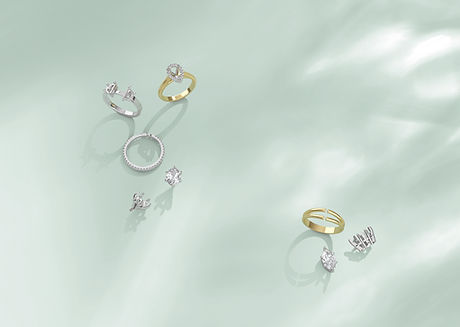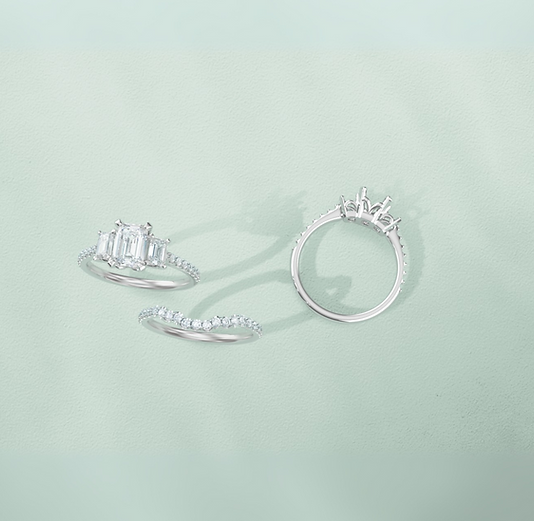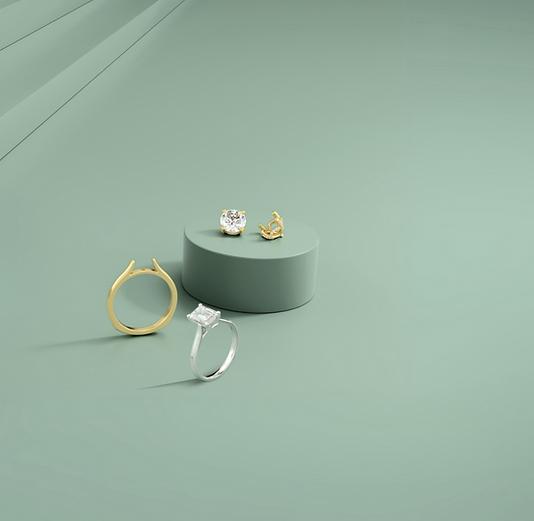Engagement Ring Settings
Explore the details that shape the look, feel, and wearability of your engagement ring.

Solitaire
A solitaire setting proudly showcases a single center stone held by 4, 6, or even 8 prongs, offering a timeless look with adjustable stone height. More prongs mean added security, while fewer prongs allow more light through. You can customize the prong shape—rounded, claw, petite—for both style and function. The high-set option adds sparkle but may catch on fabrics, so we can lower it for those with active hands.


Halo
Halo settings frame the main stone with a ring of pint‑sized diamonds for amplified sparkle. Options include single, double, or hidden halos—hidden styles sit under the center stone for discreet shine. Halo height and metal thickness affect snag resistance and cleaning ease. It creates visual size without compromising security.
Split Shank
Split‑shank bands softly divide before reaching the center stone, offering room for accent diamonds on each side. The band width and split angle affect stone stability and comfort. Some designs include extra prongs or micro‑pavé along the split for added shine and strength. This structure balances ornate detail with wearable support.


Channel
Channel settings place stones flush between two metal tracks, creating smooth, secure rows without prongs. The width of the channel influences how protected the stones are and impacts ring durability. Channels are less likely to snag and well-suited for daily wear, but the recessed channels can trap dirt, requiring regular cleaning to maintain its sparkle.
Pavé
Pavé bands shine with tiny diamonds tightly set along the band, creating continuous sparkle. The size and density of the stones affect both brightness and maintenance needs. Fine pavé can look delicate while maintaining structural integrity with proper care.


Bezel
Bezel settings fully or partly encircle the stone with metal for strong protection and a sleek profile. There are full, semi, flat-edge, and east‑west orientations that impact how much of the diamond is covered and how light enters. Bezel rings are highly durable and ideal for active lifestyles. They allow for unique designs without sacrificing safety.
Toi et Moi
Toi et Moi rings showcase two stones set side by side, often of similar size and style, to symbolize balance and togetherness. Each stone is securely held with shared prongs or bezels providing extra protection. Combining different stone types, such as a diamond paired with a colored gemstone, adds a personal touch while maintaining the ring’s structure. The orientation, prong style, stone shape, and setting height all influence how the ring wears and the care it requires.


Three Stone
Three‑stone settings frame a center gem with two sturdy side stones, distributing weight and reinforcing structural support. Accent stones can be prong, bezel, or channel‑set, adjusting both shine and resilience. The low‑profile designs are easy to wear every day and cleaner to maintain. This setting combines symbolism with solid build.
Filigree
Filigree settings feature metal designs like scrolls and lace under or beside the stone that subtly reinforce the ring’s structure. The detail can help reduce the risk of stone loosening compared to fully exposed designs. However, openwork is more delicate than solid settings so it requires extra care—regular cleaning to prevent buildup and gentle handling to avoid bending or snagging. Vintage style bands can be set lower or supported with under‑gallery arches for added strength. These rings offer charm and craftsmanship with thoughtful support.


Cluster
Cluster settings place multiple small stones tightly together to imitate a larger center stone or create floral patterns. The gems support each other structurally, reducing movement. They’re often flush-set to avoid catching on fabrics and polished smooth for comfort. The grouped design delivers strong sparkle and better edge protection than a single stone.
Cathedral
Cathedral settings lift the center stone with arched side supports that both highlight the gem and protect it. The arch height affects profile and snag risk—lower arches work better for daily wear. The style offers structural integrity and room for hidden design touches under the stone. It balances impact with practicality.


Hidden Halo
Hidden halos feature accent stones beneath the center gem, adding sparkle from the side without overwhelming the top view. While some designs may sit slightly higher, many are crafted to allow a wedding band to sit flush or nearly flush. This setting adds hidden charm with a clean profile—often without snagging.





